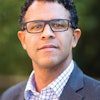For those with an appreciation or interest in architectural marvels, Isfahan, an Iranian city famed for its splendid architectural heritage, is a good place to be. Isfahan was the capital of the Safavid Empire and is studded with extraordinary architectural works from the height of their glory in the 16th and 17th centuries.
Dr. Mohammad Gharipour, a tenured associate professor in the Morgan State University (MSU) School of Architecture and Planning, was raised in Isfahan. He credits weekly visits to the Grand Bazaar, which dates back to the 11th century, with developing his curiosity about the aesthetics and history of architectural monuments. A friend of his father was an architect, and Gharipour remembers spending hours poring over the slides and photos of temples and buildings the friend took during his travels all over the world.
Gharipour went on to obtain a master’s in architecture at the University of Tehran and to work as editor at Abadi, a prominent architecture journal in Iran. The wider world was calling, however. He earned a Ph.D. at the Georgia Institute of Technology, studying under professor Douglas Allen, a visionary landscape architect who passed away in 2014.
Since 2004, Gharipour has balanced teaching and a prolific record of writing and publishing. “He’s very rigorous in his scholarship,” comments Dr. Mary Anne Akers, dean of the MSU School of Architecture and Planning.
One of Gharipour’s recent notable accomplishments was founding the International Journal of Islamic Architecture (IJIA), which is sponsored by the Agha Khan Program for Islamic Architecture (AKPIA) at MIT and is published biannually.
Akers calls Gharipour an “architectural anthropologist.” “His take on architecture is that it always exists within a cultural context,” she says. “He has a grasp on how Muslim culture [is] manifested in the architecture, whether it’s a mosque or other gathering spaces, like gardens and similar spaces. It’s the manifestation of culture within the built environment.”
As of late, the architectural heritage of the Islamic world faces grave threats. In the midst of political upheaval, certain groups have targeted architectural monuments for destruction. After ISIS militants captured the ancient city of Palmyra over the summer, they have since set about systematically destroying iconic monuments — the Temple of Baalshamin and the Arch of Triumph, among others — that have stood the test of time for millennia. The rationale behind the destruction is the same that motivates any sort of iconoclasm: when a group seeks to establish its dominance, obliterating symbols of older or different powers is one way of going about it.




















